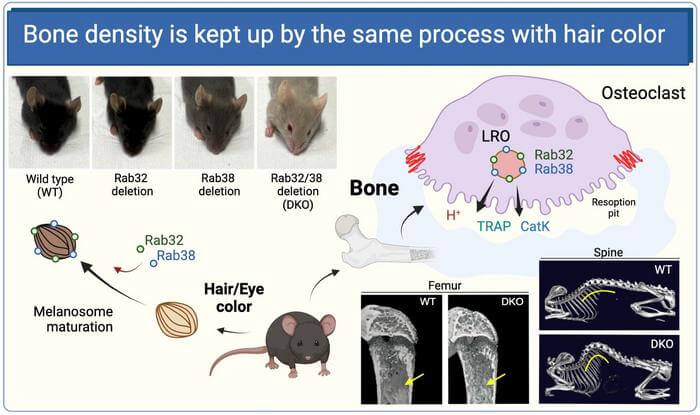Bone is maintained via delicate balance between formation and resorption, and its imbalance leads to bone related diseases like osteoporosis rheumatism and periodontitis. In studies published in scientific journals J Biol Chem and Cell Struct Funct, researchers led by Osaka University revealed proteins named Rab32 and Rab38 play pivotal roles in bone resorption in osteoclast, cell specialized in the process. These proteins are also crucial for pigmentation of hair and skins.
Bone is resorbed by specialized cell called osteoclast, and several substances are secreted out to the pits where osteoclast attaches to bones and resorption occurs, like acids (H+) and degrading enzymes (TRAP, CatK). Rab is a group of small proteins that regulate the logistics between diverse compartments inside the cells called organelle. Over 50 Rab proteins are known in mammalian cells including human and mouse, and they are thought to be specifically involved in the traffic between each specific organelle, thereby reliable logistics between them are guaranteed.
“Despite osteoclast should employ Rab dependent traffic, which Rabs are involved had been scarcely understood” says lead author of the first paper, Kazuya Noda. “To better understand the molecular mechanisms of osteoclast function, we first screened Rab proteins especially induced during osteoclast formation in mouse.”
Rab38 was found to be elevated during differentiation into osteoclast. Importantly, Rab38 has closely resembled partner Rab32, and both of them are known to be important for determination of hair color, by regulating the logistics to melanosome, an organelle specialized for color pigmentation in skin and hair forming cells.
In the second paper, lead author Kanako Tokuda constructed mouse deleted of both Rab32 and Rab38 from whole body, namely double knock out mouse. As expected, double knock out mouse shows beige-like hair color and red eyes, while wild type mouse has black hair and eyes. Interestingly, double knock out mouse shows increased bone density and as the age progress, the spine becomes more bent especially in male mouse.
“We also showed bone resorption by osteoclast is defected in doble knock mouse” says co-senior author of the second paper, Shiou-ling Lu. “We revealed Rab32 and Rab38 engaged organelle, LRO, is important for bone resorption by osteoclast”.
Significantly, bone related diseases like osteoporosis, rheumatism and periodontitis are associated hyper activation of bone resorption by osteoclast. “Therefore, understanding the underlying mechanism of bone resorption facilitated by Rab32 and Rab38 will provide us useful information regarding potential treatment target for these diseases” says senior author of the two papers, Takeshi NODA.

